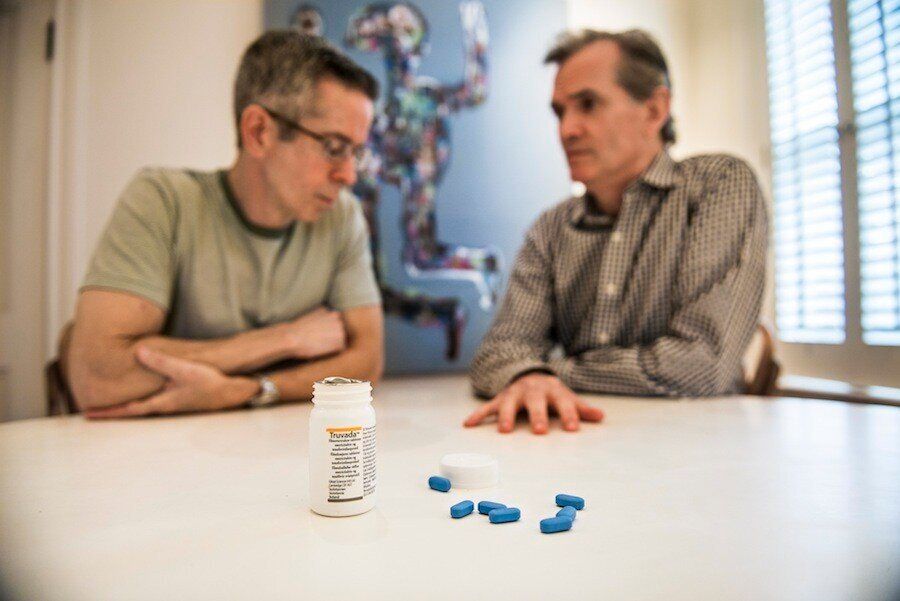D owntown Milford, population 1,021, is a picturesque street surrounded by forested hills. In the fall, sheafs of dried autumn corn decorate the lampposts; pumpkins sit outside shops with wooden signs. Prominent AIDS activist Sean Strub first came to the Pennsylvania town in 1996, looking for a quiet place to recoup from his long and brutal illness. He'd begun a recently approved regimen of 16 pills a day -- the most effective treatment for HIV ever discovered to that point. He acclimated nicely to Milford, planning for a future he hadn’t always thought he’d live to see. He helped start a film festival, published a magazine, and eventually co-purchased the Hotel Fauchere, a dilapidated historic hotel and restaurant that he painstakingly revived over five years. Friends came to visit. Some stayed. Among them was his dear friend and fellow AIDS survivor Peter Staley, who arrived in 2004 and settled close by.
One recent afternoon, Staley and Strub sat down for lunch at Strub’s hotel to talk about PrEP, a new drug regimen that has fueled debate from Provincetown to San Francisco, entering the conversation even in this bucolic outpost an hour and a half outside New York City. The daily pill is the first drug ever that can prevent men and women from contracting HIV, and has been shown to reduce the risk of infection by as much as 92 percent. With condom use declining sharply among gay men over the last decade, public health officials have hailed PrEP as part of the the solution.
Despite its successes, PrEP has doubters. Some gay men worry it will further discourage condom use -- which remains the gold standard of prevention against most sexually transmitted diseases, with a 99 percent effectiveness rate when used properly. Others warn about unpredictable outcomes for both individuals and society at large. Strub and Staley have been in opposite camps for the past several years. This was the first time the pair had met face to face to discuss PrEP, and their conversation was intense, passionate and sometimes stinging. The men love each other dearly, and yet they, too, have been swept up in the controversy.
PrEP is the first drug ever that can prevent people from contracting HIV, and has been shown to reduce the risk of the infection by as much as 92 percent.
Staley and Strub met nearly 30 years ago, when they were in their 20s. They had just joined ACT UP, which would become the most influential AIDS activism group in the world. At the time, neither man thought he’d live to see 30. AIDS was destroying their immune systems and killing off their friends, and the sitting president, Ronald Reagan, had yet to mention the disease in public. Strub and Staley felt the political and medical establishment had failed them. Along with thousands of others, many of whom are not alive today, they stormed the Food and Drug Administration demanding better drugs, faster; they lay down in the aisles of St. Patrick's Cathedral in New York City to oppose the Catholic Church’s ban on condoms; they gathered at the Capitol Mall to witness the unveiling of the AIDS Memorial Quilt, gazing at the panels of the friends they’d lost. They’re fond of one memory in particular -- the day they balanced on the roof of former Sen. Jesse Helms's home in Arlington, Virginia, unfurling a theatrically massive prophylactic over the walls.
Amazingly, their tactics worked. The pharmaceutical companies slashed their prices and sped up trials; the government cleared away the regulatory hurdles. Perhaps most importantly, AIDS entered the national conversation, and the country was forced to reckon with the consequences of ignoring the disease. In 1996, a powerful new class of drugs emerged. By then, Strub was on the brink of death, and Staley, while stable, wasn’t getting any better. The “protease inhibitors,” as the new drugs were called, came along in time to save both of their lives.
Through it all, they became close friends, sharing a summer rental on Fire Island and sailing the Sea of Cortez in a 46-foot sloop Staley rented one winter. But in recent years, neither has seen the other as often as he would like. Their activism has taken them in different directions. Strub remains a fierce critic of the government and a leader in combating what he sees as the ongoing stigmatization of the disease. He helped start the Sero Project, a network of people with HIV dedicated to raising awareness of the injustices still faced by people with HIV -- for example, the case of the gay man in Iowa who received 25 years in prison for having sex without disclosing his HIV status, despite using a condom and posing no risk of transmission. (That conviction was reversed this year by the Iowa Supreme Court.)
Staley, meanwhile, has become a government adviser; he spends most of his time volunteering on New York Gov. Andrew Cuomo’s AIDS task force, which is promoting PrEP as one of three key strategies to combat the disease in the state.
PrEP, or pre-exposure prophylaxis, is a term used to describe a preventive approach to medicine, the concept of taking a drug before illness strikes. When people take anti-malarial drugs before traveling to certain areas of Africa, they’re participating in a PrEP regimen. But the anti-malarial regimen ends soon after the trip is over. By contrast, when people apply PrEP to HIV, they’re signing up to take a pill every day for as long as they’re sexually active, perhaps the rest of their lives.
The pill used to prevent HIV is called Truvada. It’s been around for a decade as part of a treatment for people who have already contracted HIV, but the FDA first approved it for PrEP in 2012. Then, earlier this year, government officials threw their support behind it, recommending that hundreds of thousands of Americans at risk for HIV should consider the daily pill. Many in the AIDS community embraced PrEP as at least part of the answer to the ongoing epidemic: Despite the huge medical and social advances that ACT UP helped bring about in the ‘90s, the number of new infections each year has hovered around 50,000 for more than a decade, and in 2010, the most recent year for which numbers are available, more than 16,000 died in the United States alone. But some in the gay community disapproved of the government endorsement, warning that health officials may be overlooking certain dangers.
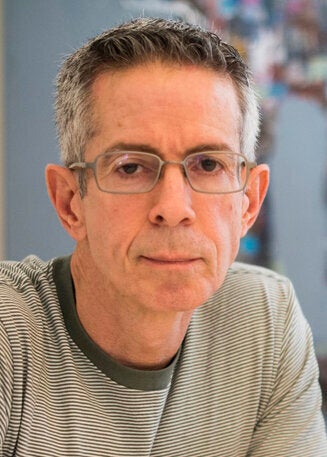
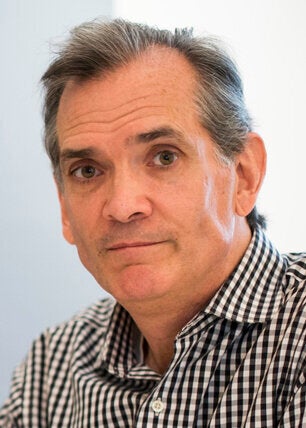
The debate has often been framed in black-and-white terms: You’re either pro-PrEP, or against it. Strub and Staley present a more complicated view -- that gay men may still disagree fiercely even if it is over subtle differences in how the pill should be used.
Staley, the Cuomo adviser, believes in the drug’s potential; Strub, the government critic, doesn’t doubt its efficacy for individual users, but is skeptical of the government’s blanket endorsement of it to all gay men. As we picked apart a sushi pizza, a local speciality, Strub, who is 56, expounded on his distrust. His advocacy work hinges on the conviction that every gay man should have have access to the education needed to be an authority on his own sexual health, and on the range of treatment and prevention choices available to him. Along with his fellow AIDS activists, he worked for decades to instill an appreciation of those values in the gay community. Now along comes a simpler solution, a little blue pill, that could replace all of that. Americans, he said, like “quick fixes. We like something that seems easy, something we can buy.” Staley, who is 53, listened patiently, his handsome face betraying no sign of emotion. A long moment of silence followed. At last, he spoke, his stern expression relaxing into a warm grin. "Jane, you ignorant bitch," he said. An inside joke. The two men leaned forward across the table and laughed. But later, in an email, Staley confessed that the meeting had left him "flummoxed."
Thirty years after Strub and Staley helped launch the fight that saved untold lives, including their own, each is convinced that his old friend is making a terrible mistake.
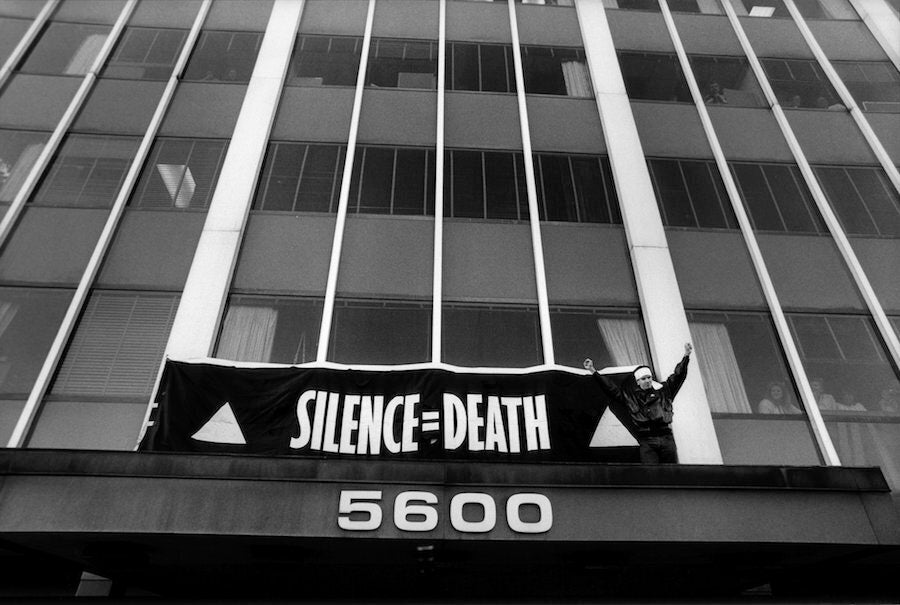
I had met Staley earlier that day outside his apartment in Brooklyn, where he lives when he’s not in Milford, and we set off for the Poconos in his silver Lexus. He is still thin as a wisp, with the sculpted jawline and cheekbones that made him an activist heartthrob in his youth. He took advantage of the ride to fire off the opening salvo. Speeding out of the city, weaving through traffic, he said there’s no longer any real question about whether PrEP can prevent people from contracting the disease. “That story is done,” he said. “And the few out there who still think otherwise are really being anti-science at this point.”
Staley is aware of the arguments against embracing PrEP as a solution to the crisis, and he agrees with some of them. He knows that HIV is most prevalent today in communities of need and color, where, among other factors, gay men are less likely to be open about their sexuality and, therefore, less likely to ask their doctors for preventive drugs. Then there’s the concern that scientists haven’t done enough research on the preventive uses of Truvada. Staley isn’t moved. “What’s your cutoff? Is 20 years of data enough to say it’s not going to shorten your lifespan? Is 30?” he said. “You have to let the science guide your activism.”
Staley’s faith in science and industry has deep roots. His father, a “Rockefeller” Republican, worked as a plant manager for Procter & Gamble. After college at Oberlin, Staley followed his older brother to Wall Street. “All this stuff just gave me a real understanding of how corporate America worked,” Staley said. “I just had this complete lack of intimidation about those kinds of structures.” It was his illness that turned him into an activist. At one point he led a protest at the New York Stock Exchange over the high price of AZT, the first drug approved to treat HIV. The protesters sneaked onto the trading floor and used foghorns to drown out the opening bell, shutting down the exchange. A few days later, the companies slashed the price for a year’s worth of the drug from $8,000 to $6,400. Staley described that protest, and others like it, as “the highlights of my life.”
But, he continued, “I also really admire a brilliant inside game.”


From the beginning, Staley said, there was a divide within ACT UP between those who wanted to remain in the streets as classic social activists, and those who coveted a seat at the table of pharmaceutical companies, the National Institutes of Health and the Centers for Disease Control and Prevention. Staley thought that avoiding the inside game amounted to “shooting yourself in the foot.” For decades now, he has spent time serving on government committees, including President Bill Clinton’s National Task Force on AIDS Drug Development. In the ‘90s, he advised drug companies on their strategies for dealing with AIDS, and in 2000, he created a website called Aidsmeds.com helping those with HIV navigate their treatment options.
Some fellow activists thought of Staley as a traitor. Strub never went that far, but he didn’t see eye to eye with Staley either. “I think Peter has more confidence in institutional systems and authority than I do,” he said. He traces his outlook in part to his middle-class childhood in Johnson County, Iowa, which at one point had the highest concentration of MDs of any county in the country. “I didn’t grow up seeing the doctor as the guy in the white coat who is God,” he said. “I grew up thinking the doctors were the most difficult to collect from on my paper route.”
Strub is handsome too, with salt-and-pepper hair and a wide, warm smile, and he doesn’t look any more the rabble-rouser than Staley. At the restaurant, he wore a crisp pale pink shirt, ordered oysters, and talked about his plans to go on an African safari with his husband. Strub and Staley nodded about their mutual distaste for slut-shaming, a major flashpoint in the PrEP debate. (Last month, actor Zachary Quinto voiced the sentiment in an interview with Out Magazine. “We need to be really vigilant and open about the fact that these drugs are not to be taken to increase our ability to have recreational sex,” he said.) Strub: “I defy anyone to accuse me of that.”
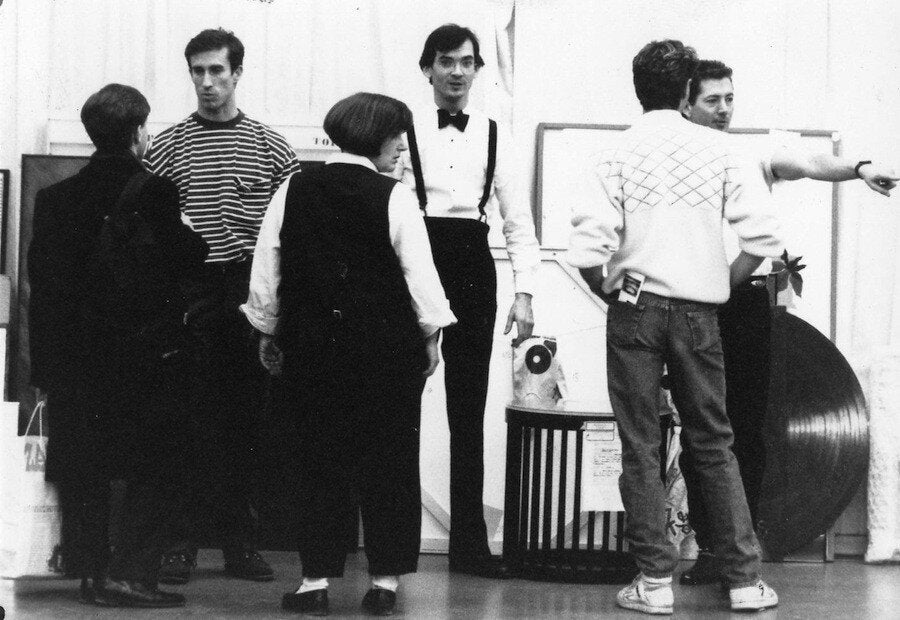
By the time the food arrived, they had moved on to more divisive topics. “I don’t think we have a strategy right now to end the epidemic,” Strub said bluntly. He argued that the gay community’s obsession with PrEP was distracting activists and funders from serious problems affecting gay men with HIV, like the lack of good health care in low-income communities, and the ongoing stigmatization that still causes so many men to keep silent about the disease. “Those are massive problems, but I think they’re seen as so big, that we practically quiver in the face of them,” Strub said. “There’s no pill to treat stigma.”
Staley nodded, took a sip of tea and cleared his throat. Without a vaccine or cure for AIDS, “I don’t see how one completely ends the epidemic,” he responded delicately. “But I do think we have the tools to dramatically lower infections as long as we have the resources and the political will to apply them, and that’s worth fighting for.”
Strub wasn’t so sure. “Some people involved in AIDS work have, in the kindest and most generous definition of the term, a paternalistic view of many of those greatest at risk,” he said. When ACT UP started, its members were fighting for their own lives and the lives of their friends. Today, the most prominent AIDS activists barely know the people most likely to die of the disease. Strub questioned whether they should be pushing drugs on them. “There’s a role for PrEP,” he said. “But I think it should be left to individual clinicians and patients who are interested in it and able to adhere properly to it.”
The question of adherence is a big one. Doctors who prescribe PrEP require patients to come in for checkups and testing every three months. But those who are most at risk of getting HIV are so unlikely to apply such vigilance -- or, in some cases, even to have health insurance -- that the idea seems laughable to Strub. The cost doesn't help — without insurance, it's about $8,000 to $14,000 for a year's supply of Truvada. And according to studies, if people fail to take the drug consistently, its effectiveness drops considerably. Staley agrees this is a formidable challenge.
“I don’t think there’s any illusion that solving HIV infections among young gay men of color is going to be solved by throwing PrEP at them,” Staley said. But, he reiterated, public health officials and AIDS activist should use “all available tools to try to reach those communities.”
Strub’s fears extend especially to one of the groups most at risk for HIV infection -- youth. He predicts PrEP messaging will override all other aspects of a conversation about safe sex, leaving another generation of gay men unversed in the risks that come with condomless sex with multiple partners: not just HIV, but syphilis, hepatitis B and any number of undiscovered germs and viruses waiting for a chance to explode through humanity.
“What I have a problem with,” Strub continued, “is when public health officials, and we collectively as a community, are sending a message to an 18-year-old coming out of the closet, ‘This is what you should be doing.’”
Staley argued that Strub’s scenario is farfetched, considering only some 26 percent of gay men have even heard of the drug.
It’s too early to say whether PrEP promotion and distribution will drain the budgets for other HIV prevention and treatment strategies. The San Francisco Department of Public Health, which has been a leader in PrEP distribution, declined to share its annual budget with The Huffington Post, but a spokeswoman said in an interview that PrEP will not replace other public health strategies. “We do think it is a very valuable public health intervention which we are actively promoting and seeking to ramp up use of in San Francisco, but the way we’re thinking about PrEP is that we’re incorporating PrEP into our total approach to intervention,” said Susan Philip, the director of disease prevention and control for the department.
PrEP isn’t the only therapy shown to prevent HIV transmission. PEP, or post-exposure prophylaxis, has a clear advantage over PrEP: A patient begins treatment only after being exposed to HIV, and then only takes it for a month, not a lifetime. At lunch, Strub said he found it suspicious PrEP has been getting all the attention. (Cuomo’s task force, for example, didn’t mention PEP in its press release announcing the group’s plan, but did include PrEP as one of three central points of focus.) Could financial motives have something to do with this trend? he asked. A pill a day, after all, equals a lot of money for the pharmaceutical industry.
“It’s a crime that PEP is not central to our prevention efforts,” Strub said.
(Staley said he wants to make both PrEP and PEP widely available.)
Strub and Staley credit their survival to drugs. Over the years, they’ve each taken more than a dozen medications in different combinations: AZT and Crixivan, Viread and Norvir. The onslaught of chemicals has taken a toll, but Strub is more concerned about the side effects than Staley, perhaps because of his inherent distrust of the pharmaceutical industry, perhaps because the drugs made him sicker. Four years ago, he stumbled on a curb and broke his ankle in three places. The doctor diagnosed him with profound osteoporosis. Strub blames the Viread -- which happens to be a component of Truvada. He worries that Truvada, taken daily, could have similar consequences.
A waitress came and took away the oyster shells and the last crumbs of sushi pizza. As we walked outside into the bright autumn day, Staley smiled at Strub. “You can have the last word on the way back,” he said.
![The "poison dart" by artist Barton Benes. The piece is a hypodermic needle with Strub's blood splurging out of it. "[It] required me to get my doctor to let me leave his office with a vial of blood, which wasn't easy," Strub said. "I eventually talked the phlebotomist into drawing an extra vial and I snuck it out of the office." (Photo by Damon Dahlen)](https://img.huffingtonpost.com/asset/5e987b7725000079216b7eaa.jpeg?ops=scalefit_1280_noupscale)
Strub lives a few houses down from the restaurant, in a home filled with artifacts from the movement's heyday. There’s the oil painting of his fellow ACT UP activist Stephen Gendin, who died in 2000 of AIDS-related lymphoma, and a piece by one of Strub’s closest friends, the artist Barton Benes, who died two years ago. On one wall hangs a clock by Nayland Blake. When Blake made the piece, in the early '90s, a person was dying of AIDS every 12 minutes. Blake marked the clock at the 12-minute intervals. “Back then we were outraged there were that many,” said Strub. “Now its like, ‘Eh, it’s stabilized.’” He shrugs. “The gay community has abandoned the epidemic.”
Strub and Staley both look back at their youth with some nostalgia. Even though they were dying and surrounded by death, they described a sense of excitement and solidarity that doesn’t exist in the world of AIDS activism today.
The Jesse Helms incident was a highlight. In September 1991, Staley, Strub and five other ACT UP members rolled up to the senator’s house in Arlington, Virginia, in a rented U-Haul. Inside the truck was a massive cloth balloon shaped like condom on which one of the activists had stenciled the phrase, "HELMS IS DEADLIER THAN A VIRUS." Staley and Strub were the roof guys, charged with transporting the unwieldy prop up a 28-foot ladder to the top of the house. Staley pulled; Strub pushed. Below, cops and neighbors gathered.
“The gay community has abandoned the epidemic.”
The owner of the house wasn’t home that day, but a week later on the Senate floor he complained about the stunt, blasting the activists as “radical homosexuals.” Helms was one of the movement’s most hated adversaries. From his office on Capitol Hill, he led the charge against gay rights and federal AIDS funding, once claiming in a debate, "There is not one single case of AIDS in this country that cannot be traced in origin to sodomy.” Of gay people, he said, "It's their deliberate, disgusting, revolting conduct that is responsible for the disease."
It’s impossible to imagine a sitting congressman saying that today. Even Republicans are coming out in support of gay rights and marriage equality, and those who remain opposed to gay causes are careful to avoid the appearance of bigotry. Without an obvious common enemy, there is less to hold the community of AIDS activists together. Some activists, like Staley, support the establishment they once fought, and take some credit for pushing Big Pharma and the government to change. Others, like Strub, are skeptical that the system has changed in a truly meaningful way. Their personal experiences have shaped their views, and it seems unlikely they’ll ever see eye to eye.
A day after the meeting, Staley sent me an email, breaking his promise to give Strub the last word. “While I’ll always treasure Sean’s friendship,” he wrote, “I was painfully reminded during our PrEP discussion why I avoid talking with him about HIV prevention and treatment, much like I avoid talking to my FOX News-watching dad about politics.”
"My only comfort is knowing his views are not widely shared by the AIDS activists I meet around the world,” he said.
Strub, of course, could have said the same thing about Staley.
Enjoy reading this article? Read more selections from the best of HuffPost in Huffington Magazine.
